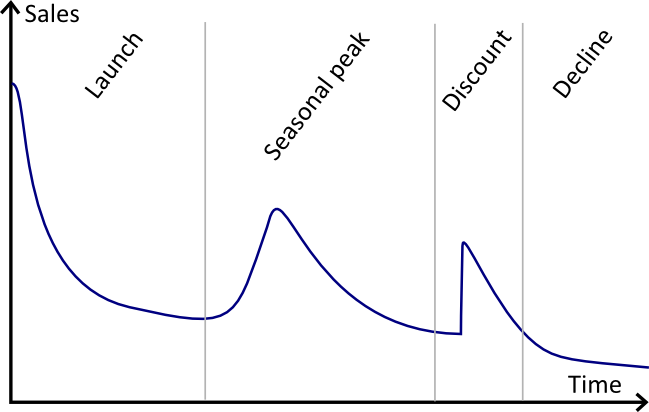Product Life-cycle (Supply Chain)
The product life-cycle represents the various market stages - namely development, introduction, growth, maturity and decline - that occur for the vast majority of consumer packaged goods. From the inventory management viewpoint, the product life-cycle is one of the major demand pattern along with seasonality or trend that needs to be accounted for in order to maintain the desired service levels.
Classic market stages

The classic economic theory states that a product, after the development stage, goes through 4 market stages:
- Introduction where there is only a limited awareness of the market for the product.
- Growth as more prospects turn customers as they discover the product. At this point, competitors enter the market, and ultimately limit the growth.
- Maturity is reached when the growth is halted but the sales remain steady because a market balance is found between the product and its competitors.
- Decline happens as later, more competitive products gradually erodes the sales. The decline can be accelerated if the product is actively phased out of the market.
Classic analysis is inclined toward profitability analysis tailored for the manufacturing perspective: the short-term monopoly obtained during the introduction phase is leveraged to generate extra-profits that cover development costs. This is a practical example of the creative destruction theory of Joseph Schumpeter.
Cannibalization driven life-cycle
For many FMCG (fast moving consumer goods) producers, the product life-cycle is not driven by the competition, but by the producer itself who keeps pushing new products to the market (possibly bringing only superficial change to the product). New products quickly cannibalize the sales of the older products. The same phenomenon is observed in other fast paced markets such as consumer electronics.
From an inventory viewpoint, cannibalizations are more favorable, because the company has a lot more information about it own future product launches as opposed to product launches operated by competitors. Also, newly launched products are typically close to perfect substitute to the old ones, which strengthens the product life-cyle pattern.
Entertainment and fashion cycle
The life-cycle of entertainment products such as books, CD, DVD, video games follow a very specific pattern that does not entirely fit the classic life-cycle vision.

For such products, market awareness is typically built upfront, even before the sales start. Then, sales are the strongest at launch, and quickly decline afterward.
However, two surges can frequently be observed:
- a first seasonal peak (Christmas).
- a second peak caused by a significant price discount.
Afterward, the product sales typically only decline further, and subsequent seasonal peaks are typically negligible compared to the first.
This type of life-cycle patterns lead to very counterintuitive situations where a business can be booming, while the sum of its forecasts indicate a strong downward trend.
Life-cycle patterns for inventory optimization
All products undergo a market life-cyle, but it does not mean that life-cycle is of primary importance as far inventory optimization is concerned. If the life-cycle is very long compared to the lead time, then the impact of the life-cycle, at inventory level, might be dwarfed by other patterns, such as the day of the week cyclicity for example.
Forecasting the life-cycle of outstanding products is very difficult, and typically not possible with a pure statistical approach. However, such outstanding products are rare (for example the Microsoft Kinect holding the record of the fastest selling consumer electronic device).
The vast majority of products are far from being one of a kind. As a result, the best way to quantitatively assess the shape of the demand life-cycle consists of establishing a set of closely relevant products found among the records of the company.